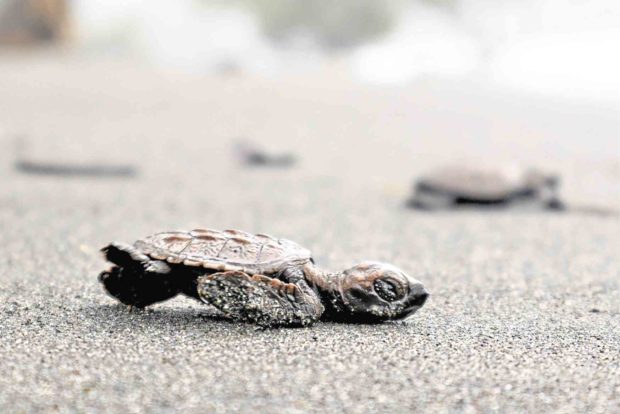Saving turtles by saving their nesting sites

A Hawksbill sea turtle hatchling crawls its way to the sea in the village of Candiis, Magsaysay town, Misamis Oriental.
BUTUAN CITY — One of the most fascinating facts about sea turtles is that they have unusually sharp memories, according to experts.
So they would return again and again to the place where turtles hundreds of years before them hatched to do the same.
The coastal area of Magsaysay town in Misamis Oriental was one of those places that experts said had been imprinted on the turtles’ memories as a hatching site.
This magnetic imprint, as experts described it, serves like a homing beacon that makes sure turtles don’t get lost and find their way back to where they hatched to lay eggs.
The only difference that marked a century from another for the turtles was the absence or presence of their hatching sites’ other inhabitants—humans.
Article continues after this advertisementHuman targets
Article continues after this advertisementIn Magsaysay, hawksbill sea turtles had become human targets.
Hawksbill turtles are classified as critically endangered, or near extinction, by the International Union for Conservation of Nature Red List of Threatened Species.
The entire population of hawksbill turtles was estimated to have fallen by as much as 80 percent in the last 10 years.
In Magsaysay town, at least four turtles were recorded to have nested—three in the village of Candiis and one in Damayuhan.
Climate change
Although the number of turtles that nested this year was higher than the three recorded in 2017, it was still low if the baseline figure would be 10-15 turtles nesting a year from 2000 to 2005, said Donato H. Bojo, zoology technician of the Protected Area Management and Biodiversity Conservation Section (PAMBCS) of the Department of Environment and Natural Resources (DENR) regional office.
The reason for the decline in the number of turtles nesting in Magsaysay was unclear but Rolando Pagara, councilor of Candiis village and in charge of conservation efforts for the turtles, pointed to climate change.
“Climate change has been a key factor in the nesting behavior as well as survival of the hawksbill,” he said.
One recent example of climate change’s effects was the rise in tide in Misamis Oriental on July 12 and 13.
On those days, tide rose by as high as 2.7 meters, hitting the turtles’ nesting sites.
Of 153 eggs at the nesting site, according to Pagara, only 40 were hatched.
Drastic
Ranoray Love A. Noro, PAMBCS section chief, said drastic changes had been happening along Misamis Oriental’s coastline.
“Sadly in just 30 years numerous changes have occurred along the entire coastline of the province,” he said.
“While climate change is a factor, other factors such as beach armoring, or creating artificial rock formation and fencing along the beach, has changed the area,” he said.
“Land use, such as the setting up of beach resorts, on a critical habitat should be considered illegal,” Noro added.
Turtles’ key role
He said having sea turtles nest in the coastline between Magsaysay town in Misamis Oriental and Carmen town in Agusan del Norte showed that the ocean ecosystem in the area was still healthy but needed protection.
Turtles’ key role
Sea turtles, Noro said, keep the marine ecosystem healthy.
Turtle poo serves as food for microorganisms and plankton, which serve the coral reefs and are food for fish and other aquatic animals, he said.
Turtles and other marine animals will go about their routines if unimpeded and the bigger challenge was how to make humans realize this, Noro said.
Pagara said although most fishermen knew it’s illegal to hunt and catch sea turtles, dead turtles without their carapace kept turning up on the shore.
Turtle carapace had become a sought after commodity in the black market because of false claims about its medicinal properties.
Decoration
Pagara said hawksbill carapace was a “primary source of tortoise shell material used for decorative and medicinal purposes.”
International law had outlawed the capture and trade of hawksbill turtles and products from these.
To protect the turtles, zoologist Bojo said the known nesting sites at Magsaysay in Misamis Oriental, covering 612 hectares, had been declared in 2012 a critical habitat of sea turtles.
Bojo said DENR Administrative Order (DAO) No. 2016-02 established the coastal villages of Candiis, San Isidro and Damayuhan as critical habitats where a total of six nesting sites had been found.
According to Bojo, conservationists found multiple hatching sites only in Magsaysay.
Centuries-old routine
“This phenomenon did not happen overnight,” he said.
“This means that sea turtles have been nesting in this area for hundreds of years,” Bojo added.
Protecting the turtles, though, faces not only challenges from a rapidly changing climate.
The population growth of humans, the other inhabitants in the turtles’ birthing places, is steadily growing.
In just 15 years, the population of Magsaysay town alone has grown from 24,550 to 34,605. —Erwin Mascariñas